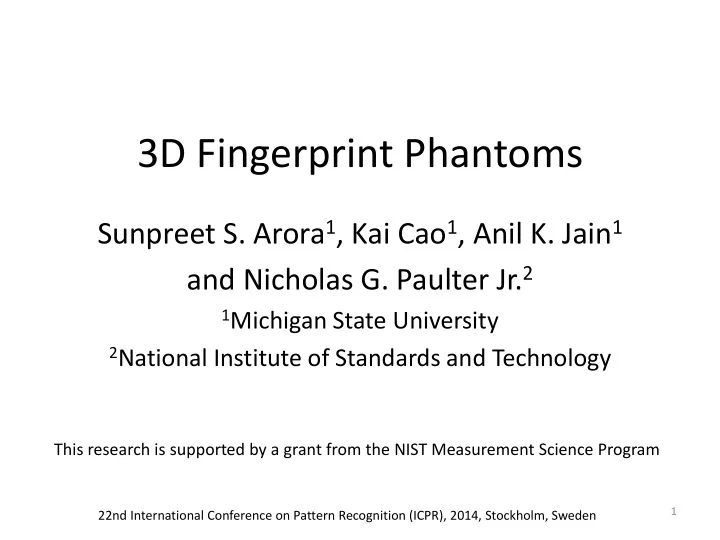

3D Fingerprint Phantoms Sunpreet S. Arora 1 , Kai Cao 1 , Anil K. Jain 1 and Nicholas G. Paulter Jr. 2 1 Michigan State University 2 National Institute of Standards and Technology This research is supported by a grant from the NIST Measurement Science Program 1 22nd International Conference on Pattern Recognition (ICPR), 2014, Stockholm, Sweden
Goal • Build 3D fingerprint phantoms/targets to calibrate fingerprint readers and evaluate feature extractors and matchers 2
Imaging Phantoms • Specially designed artifacts with known properties to evaluate the performance of imaging devices Torso Phantom to calibrate “Phannie”, a phantom to calibrate CT Scan machines MRI machines developed at NIST https://www.kyotokagaku.com/products/detail03/ph- http://www.nist.gov/pml/electromagnetics/phanni 4.html e_051110.cfm 3
Fingerprint Phantoms • 2D/3D artifacts recommended to measure geometric accuracy, resolution and spatial frequency response of imaging devices [1] [2] Ronchi target Sine wave target Bar target [1] Normal B. Nill, ”Test procedures for verifying image quality requirements for personal identity verification (PIV) single finger capture devices.” MITRE Technical Report MTR 060170, 2006. [2] Norman B. Nill, ”Test procedures for verifying IAFIS image quality requirements for fingerprint scanners and printers 4 V 1.4” MITRE Technical Report MTR05B0016R7, 2013.
Our Contributions • Build 3D phantoms to calibrate optical fingerprint sensors • Project different 2D test patterns onto 3D finger surface • Use COTS 3D printers to fabricate 3D phantoms; the hardness and elasticity of fabrication material is similar to that of human fingers 5
2D Calibration Patterns • 2D patterns with known characteristics Vertical bars Concentric circles Synthetic (ridge spacing = 10 pixels) (ridge spacing = 10 pixels) fingerprint with known features 6
3D Fingerprint Phantoms • 3D electronic and physical artifacts of known characteristics Synthetic fingerprint with Concentric circles Horizontal bars Vertical bars (ridge spacing = 10 pixels) (ridge spacing = 10 pixels) (ridge spacing = 10 pixels) known features 7
Preprocessing 3D Finger Surface y z • Align the finger surface x • Surface triangulation • Surface re-meshing [3] • Regularize the finger surface [4] • Separate front and back [3] G. Peyré, and L.D. Cohen. "Geodesic remeshing using front propagation." International Journal of Computer Vision , 2006 [4] C. Loop, "Smooth subdivision surfaces based on triangles.”, 3D finger surface 1987 8
Mapping 2D fingerprint to 3D surface y z • 3D to 2D projection [5] x • Translation, rotation v and flip correction w.r.t u reference coordinates • Make the surface dense • Determine one-one correspondence [5] J. B. Tenenbaum, V. de Silva, J. C. Langford, “A global geometric framework for nonlinear dimensionality reduction”, Frontal finger surface 9 Science, 2000
Engraving ridges and valleys • Compute the surface y z normals x • Displace the surface along the surface normals • Displacement proportional to mapped intensity value Frontal finger surface 10
Postprocessing 3D finger surface • Combine front and back • Create inner surface • Stitch outer and inner surfaces to create a watertight solid surface 3D finger surface 11
3D Fingerprint Phantom Generic 3D finger 2D synthetic fingerprint surface image with known features 12
3D Fingerprint Phantoms 2D fingerprint image 3D Fingerprint Phantom 13
3D Printing • Phantoms fabricated using a 3D printer (X & Y res: 600 dpi, Z res: 1600 dpi) using two different materials • Printing material based on finger skin properties Property Human skin Material A Material B [6] [7] Shore A hardness 20-41 26-28 35-40 Tensile strength (MPa) 5-30 0.8-1.5 1.3-1.8 Elongation at Break (%) 35-115 170-220 110-130 [6] C. Edwards and R. Marks, "Evaluation of biomechanical properties of human skin" Clinics in dermatology, 2005 [7] V. Falanga and B. Bucalo, "Use of a durometer to assess skin hardness" J. American Academy of Dermatology, 1993 14
Experiments • How good is the mapping from 2D to 3D? – Match the original 2D fingerprint image to impressions of 3D phantom • Are multiple impressions of the 3D phantom consistent (small intra-class variability)? • Calibrate optical fingerprint sensors using 3D phantoms 15
Evaluation of 2D to 3D Mapping • Match captured impressions of 3D phantom to the original 2D fingerprint image Match score: Match score: 153; threshold 180; threshold at FAR=0.01% at FAR=0.01% is 33 is 33 Original 2D Image of 3D phantom Image of 3D phantom fingerprint image using 1000 ppi scanner using 500 ppi scanner 16
Intra-class Variability of Impressions • Match different impressions of the same 3D phantom Match score: Match score: 878; threshold 410; threshold at FAR=0.01% at FAR=0.01% is 33 is 33 Impression 1 of phantom Impression 1 of phantom Impression 2 of phantom Impression 2 of phantom 17 using the 1000 ppi sensor using the 500 ppi sensor using the 1000 ppi sensor using the 500 ppi sensor
Calibration Experiments • Experimental Protocol – Capture 10 different impressions each of the three artifacts having pre-specified test patterns – Measure the mean and variance of ridge spacings 18 18
2D Images of 3D Phantoms 500 ppi sensor 1000 ppi sensor 19 Horizontal bars Vertical bars Concentric circles
Calibration Results Test pattern 500 ppi sensor 1000 ppi sensor Horizontal bars Mu = 9.04, Sd = 0.06 Mu = 9.05, Sd = 0.05 Vertical bars Mu = 9.51, Sd = 0.23 Mu = 9.46, Sd = 0.09 Concentric circles Mu = 9.80, Sd = 0.31 Mu =9.59, Sd = 0.08 Mean (Mu) and Std. deviation (Sd) ridge spacing computed in the images acquired using the two sensors. (test pattern ridge spacing = 10 pixels) Note: • To compensate for the distortion during 2D to 3D projection, we use the Euclidean to Geodesic distance ratio to adjust ridge spacing 20
Conclusions and Future Work • We have devised a method to create 3D fingerprint phantoms by (i) projecting any 2D test pattern onto a generic 3D finger surface, and (ii) fabricating using a 3D printer • 3D fingerprint phantoms can be used for calibrating fingerprint sensors, and evaluating feature extractors and matchers • Ongoing Work: (i) improve the fingerprint phantom fabrication process, (ii) study fingerprint distortion during the acquisition process 21
Recommend
More recommend